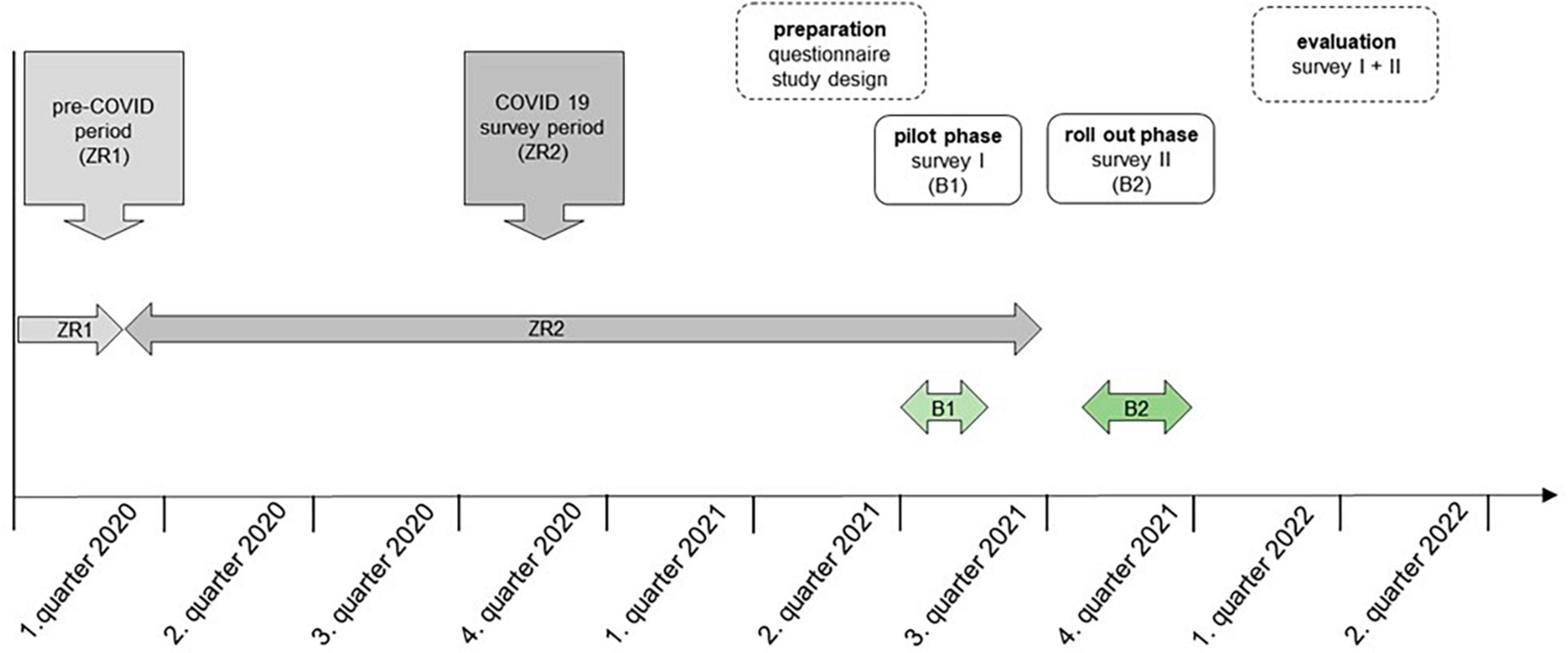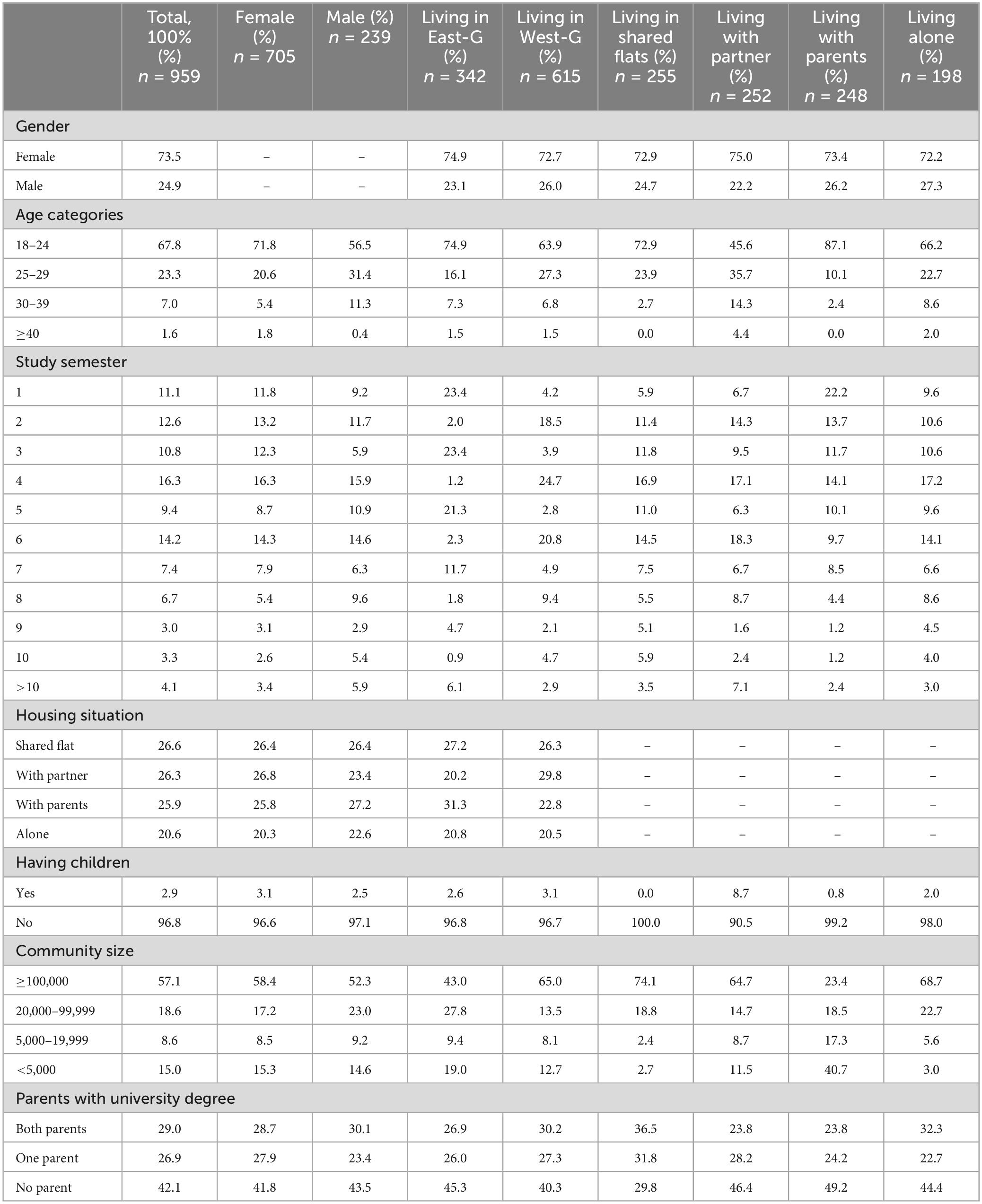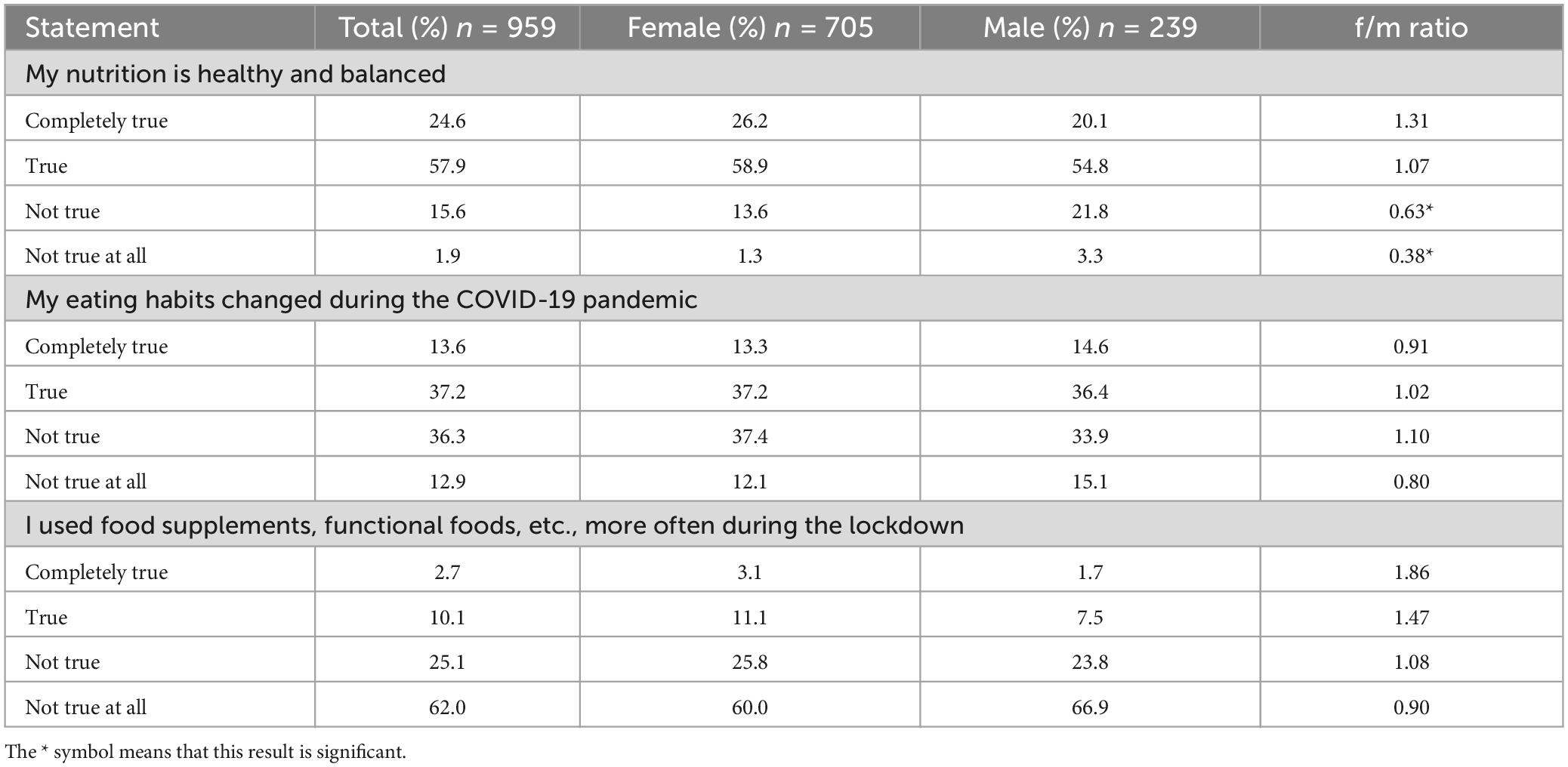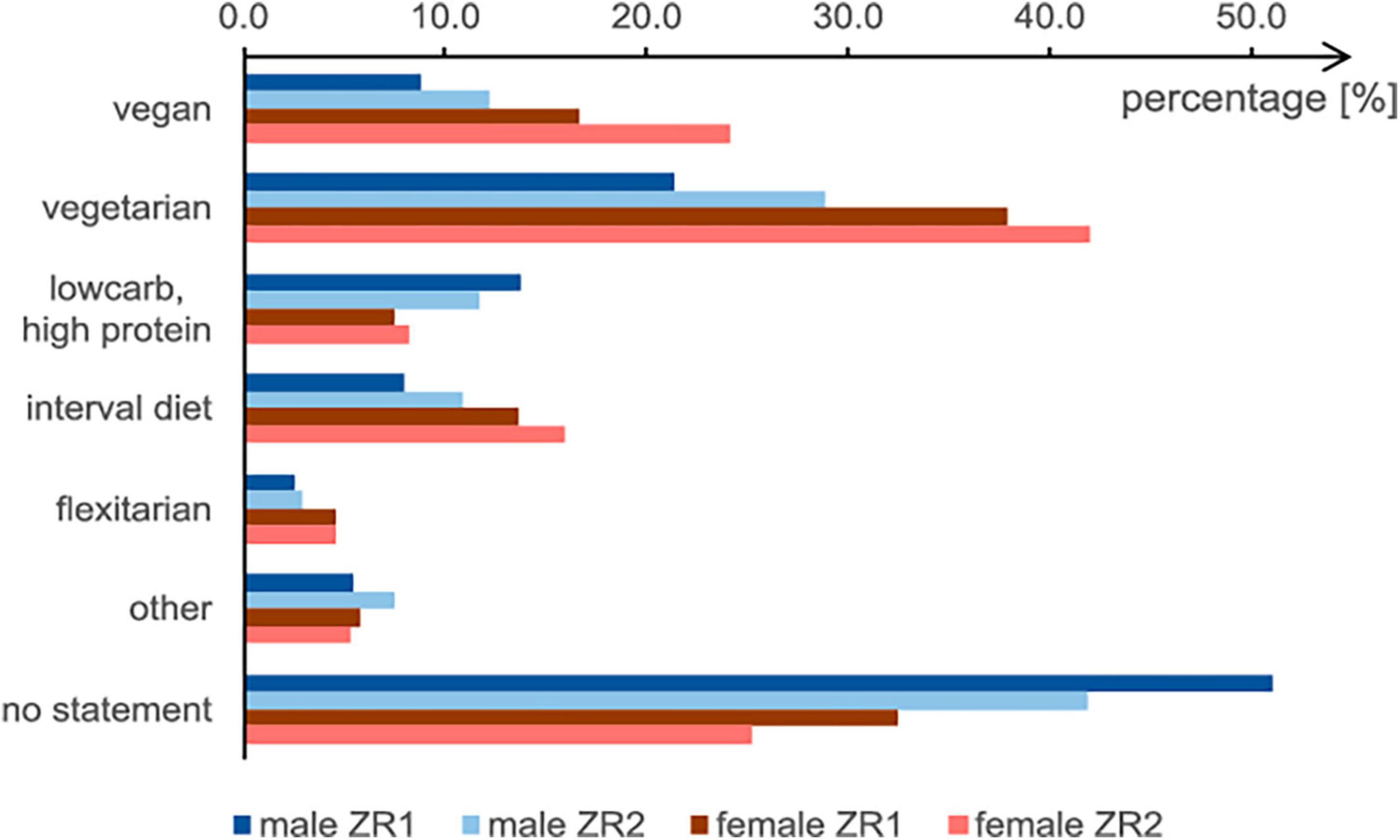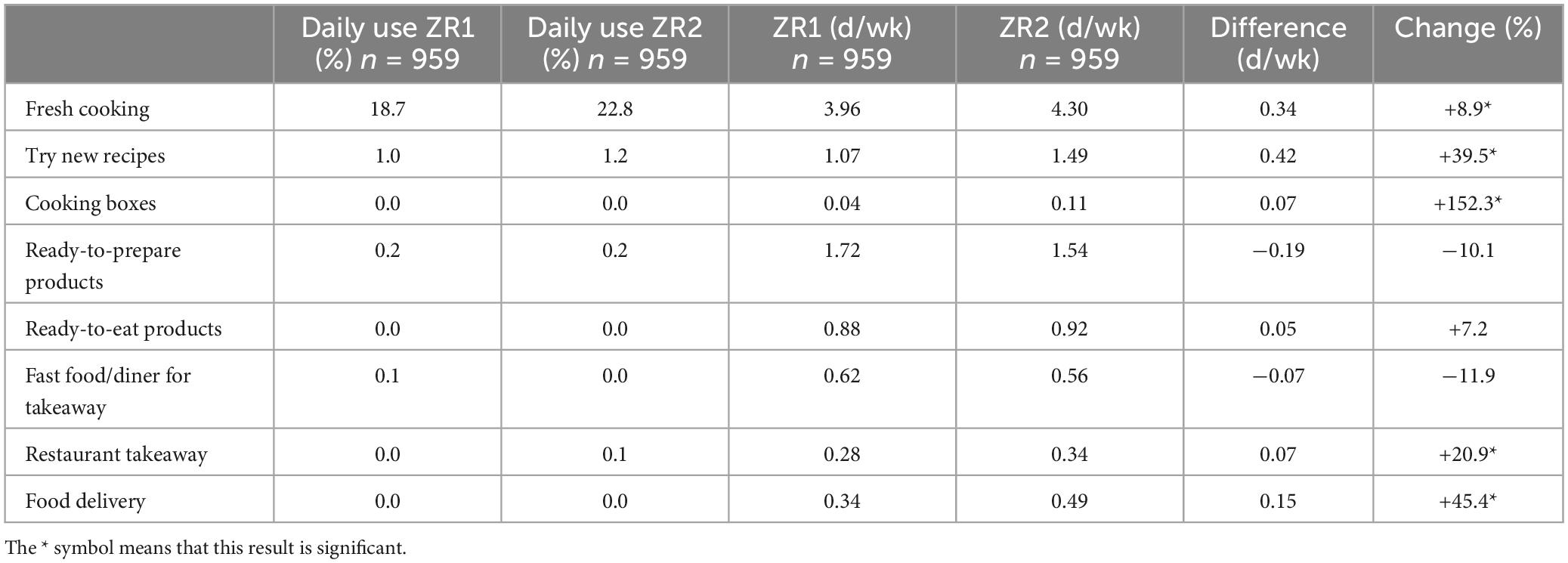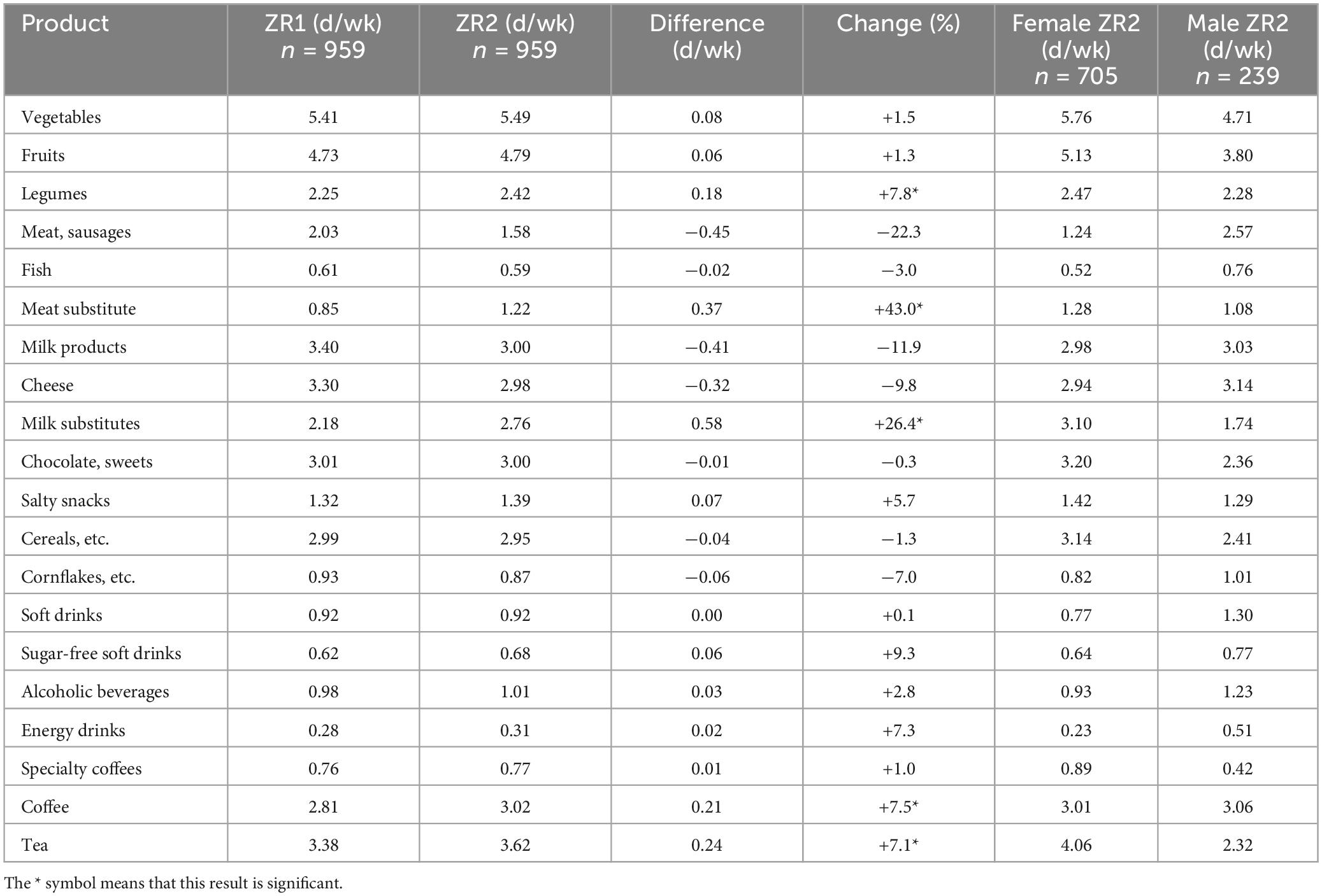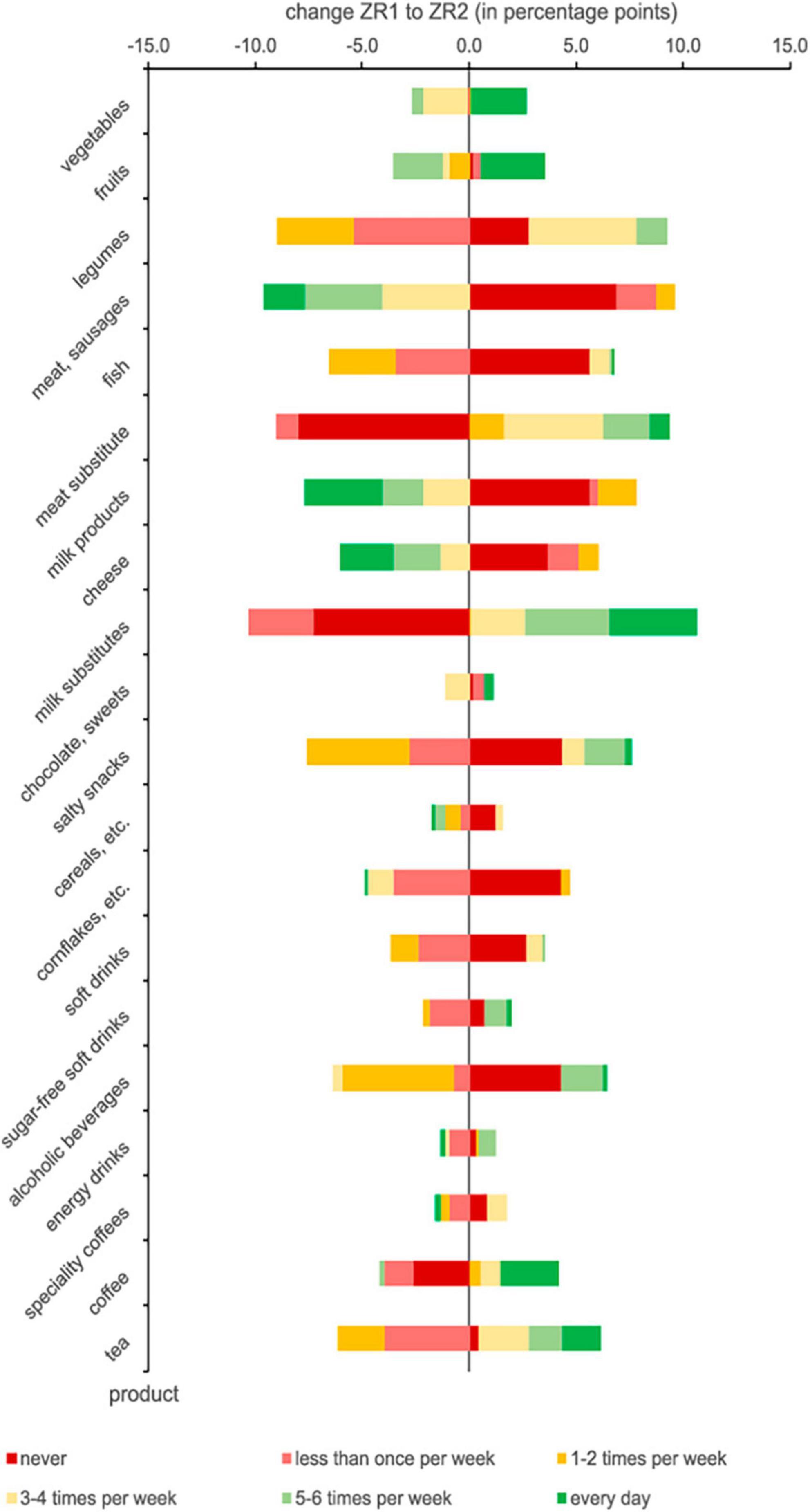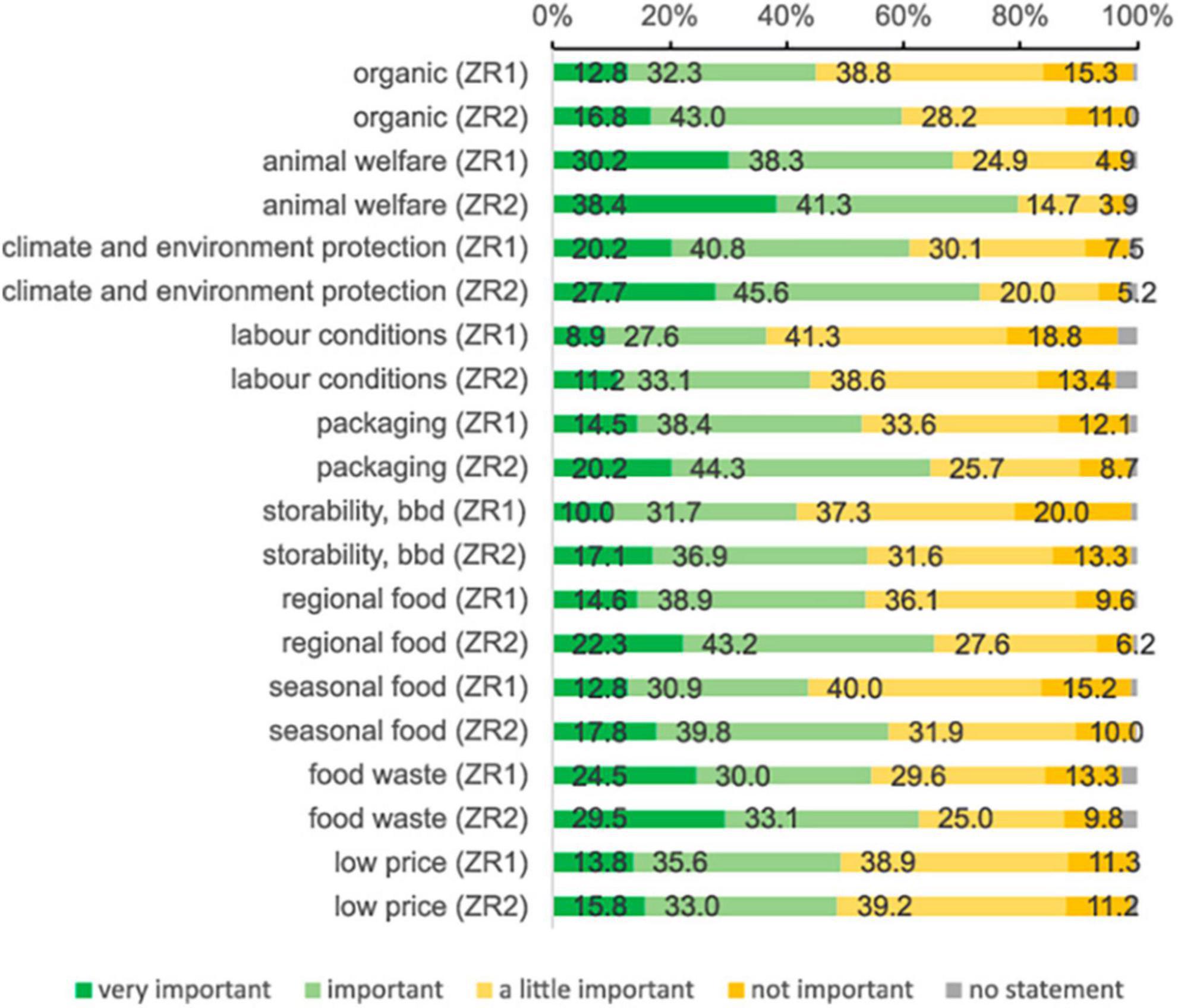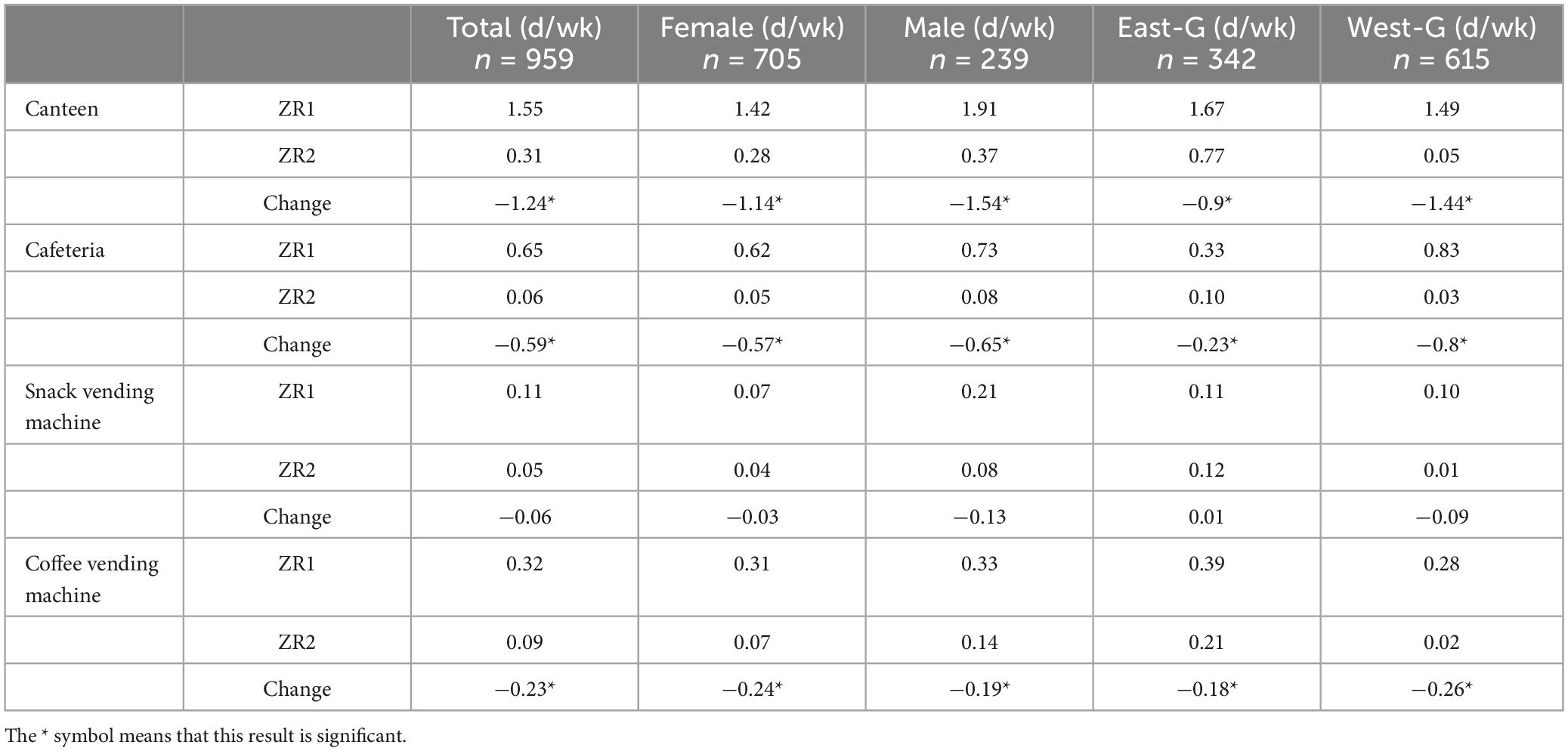- 1Dr. Rainer Wild-Stiftung, Heidelberg, Germany
- 2Institute of Nutritional Medicine, University Hospital Schleswig-Holstein, Lüebeck, Germany
Purpose: The dietary practices (DPs) of university students are influenced by many external factors. Therefore, we investigate how the DPs of students in Germany changed during the SARS-CoV-2 pandemic, what the main motivations were for those changes, and what effect the closure of university catering had on the DPs of students.
Methods: A total of 560 students from two universities in Lübeck (Germany) were surveyed online during a pilot phase. The final online questionnaire was subsequently administered at 10 other German universities (399 respondents). The questionnaire surveyed sociodemographic factors, dietary habits, food consumption frequencies, and the relevance of university catering before and during the SARS-CoV-2 pandemic.
Results: Regarding changes in DPs, similarities to previous studies were found, especially positive eating behaviors and an increasing interest in health- and nutrition-related sustainability. Students prepared meals freshly more often during the pandemic; consumed legumes, plant-based meats and dairy alternatives more often; and reduced their consumption of meat and milk compared to before the pandemic. The consumption frequency of sweets also decreased. It was observed that students consider eating communal in the university canteen to be highly relevant for their social interactions, which was only possible to a limited extent during the pandemic.
Conclusion: In Germany, the DPs of university students as well as criteria regarding health and sustainability changed during the first 2 years of the SARS-CoV-2 pandemic. The social aspect of DPs became evident due to closed university catering. Still, changes in dietary patterns and eating habits were positively related to health and revealed some differences in the cross section of the population.
Introduction
Students in Germany, as everywhere else, faced new life conditions during the first weeks of the SARS-CoV-2 pandemic in 2020. Closed universities, online lectures, and restrictions on contact, travel, and business in the retail sector and in catering, including university catering, interrupted the daily routines of most university students, thus directly affecting established dietary practices (DPs) (1) DPs describes nutrition as a daily practice that includes more than actions limited to food preparation and intake (2). They are based on routines acquired over a lifetime, with frequent repetition of certain procedures (2). Thus, when routines have proven relevant and reasonable in the individual lifestyle, actions such as shopping or cooking are no longer reflected and are only led by the compressed, accumulated knowledge (3). Since the survey for this study comprises self-reported dietary habits and nutrition instead of a controlled survey protocol, the term DP is used to discuss the results of the survey appropriately (2).
The lives of university students are mainly structured around lectures, scientific research, and part-time jobs, which secure a living but especially influence DPs. These essential activities were disrupted by SARS-CoV-2 measures (4–7). Daily routines and social communities changed drastically, also affecting housing situations and household budgets (8). Students had to adapt their familiar DPs regarding shopping, cooking, and eating routines. Alternatives had to be found for out-of-home catering, especially for affordable meals from universities’ catering canteens, which were closed during the lockdown (9), playing a further important role in the communication and socializing of young adults (1). Many students live in two places (their hometown and their place of study) and often in shared flats; hence, they have on average more social contacts in more diverse environments than most other collectives (10–12). Regarding typical life and daily routines, the DPs of students were expected to be significantly affected by lockdowns with contact restrictions or the implementation of online lectures (1).
Initial studies described the effects of the SARS-CoV-2 pandemic on the DPs of the German population already in March 2020 (13–19).
Most studies described a distinct awareness of quality in the context of nutrition, including the preference to prepare fresh food, as well as the increasing relevance of aspects such as animal welfare, climate and species protection, labor conditions in the food sector, and the reduction of food waste (8, 14, 19). As zoonoses such as COVID-19 can be related to the food system, the sensibility according dietary and ecological sustainability arose (20–22). Several studies demonstrated that a sensibility occurred already in the early stages of the pandemic (7, 8, 22–28). One review concluded that the “new normal” seemed to imply a favorable development from the perspectives of nutrition physiology and social economics (29). Since crises usually induce a revision, and sometimes even innovation, of social norms, they will also affect the individual values and attitudes of students (30).
Several studies have addressed the dietary habits and nutrition of students (31–33). However, due to the methodologies and samples, the validity of the results is limited, especially when comparing students’ DPs pre and post the pandemic (12). The Göttingen studies by Busch et al. (18) found a decreased consumption of meat and dairy products in the first months of the pandemic, as well as an increase in the consumption of plant-based alternatives (18, 19). Students were also found to prepare their meals themselves; to try new recipes more often; and to consume fruits, vegetables, and sweets or cakes more frequently (34). However, sustainability-related DPs can be expected from most students, especially young females (2, 35). Regarding meat consumption and a vegan or vegetarian diet, these DPs relate to people with higher education (36–38). The use of university catering has been addressed by only a few studies, which state its relevance especially for young students (11, 39).
The purpose of the study was to investigate the extent to which the DPs of students may have changed in the context of the SARS-CoV-2 pandemic compared to the pre-pandemic period and during the pandemic. In our study, we investigate three questions:
1. How did the DPs of students in Germany change during the SARS-CoV-2 pandemic from 2020 to 2022?
2. What have been the main motivations for changes in DPs?
3. What was the effect of closed university catering on the DPs of students?
Materials and methods
Sample and survey
The study focused on the health- and sustainability-based nutritional practices of students at the beginning of 2020 and changes in those practices during the SARS-CoV-2 pandemic from 2020 to 2022 (Figure 1). The questions of the survey were developed by the authors on the basis of already published studies (18, 19) and supplemented by aspects that should also cover the question (e.g., university catering). The already published study designs served as a theoretical foundation and to ensure validity (18, 19). The questions were drafted in German. The survey was initially conducted on students from the University of Luebeck and the Technical University of Applied Sciences Luebeck (THL) in June and July 2021 (B1). In the winter term 2021/22, the survey was rolled out to students from other German universities (B2), ending on December 31 (Figure 1). For this phase, universities in Germany that offer study programmes on the subject of nutrition were consulted. The contact addresses of the universities were researched by the authors. The internet link to the website was distributed by the Dr. Rainer Wild-Stiftung and directly sent to participating universities. The universities then informed the students about the study by e-mail and provided the link to the survey at the same time. The sample size was not determined in advance and resulted from the number of questionnaires answered by the students during the pilot and rollout phase.
Pandemic background
In 2021, the general mood in society regarding the SARS-CoV-2 pandemic in Germany was characterized by high stress and fatigue (1). After an initial decrease in COVID incidences in summer 2020, significantly more infections were reported after the holiday season and with colder weather at the beginning of the winter semester 2020/21 (19), resulting in a partial lockdown in November 2020. In the following months, vaccines became available, accompanied by discussions about safety measurements, vaccination campaigns, and compulsory vaccinations. This situation did not change before the first survey in summer 2021 (B1) (19). The second survey period was set at the end of 2021, when COVID incidences rose again.
Online tool
Survey Monkey® is a web-based survey service, was employed in this study. After the questions were established and the style of each question was chosen, the link to the questionnaire was exported and distributed via e-mail. Survey Monkey saves the IP address of each participant in order to prevent multiple participation. This excludes participants who have already taken part in the survey.. The results of the survey were exported as.csv files and analyzed using Microsoft Excel.
Questionnaire
The online survey, with a total of 26 questions, focused on the living situation, income, and dietary habits of students. Food-related questions followed the concept of a food frequency questionnaire, which asks about the frequency of consumption based on a list of previously defined foods. Relevant changes were investigated by addressing two time periods with one question: before (ZR1: ≤ February 2020, Figure 1) and during the COVID-19 pandemic (ZR2: March 2020 until July 2021, Figure 1). Questions were single- and multiple-choice (limited to choosing two response options) with the additional option “no statement.” The questionnaire was in German language. The questionnaire was first designed in a pilot phase at two universities in Lübeck (Figure 1). The data analysis in the pilot phase ensured that the questions were easy to understand, and that the questionnaire covered the research question and was therefore valid for the roll out phase (Figure 1). The criteria of the CHERRIES guideline relevant to the questionnaire are fulfilled (40): The legal framework for data privacy and data storage of both institutes was listed on the start page of the study. It was also stated here how long the survey would take (15 min) and that the survey could be cancelled at any time. It was described that participants agree to these aspects by taking part. To get from the start page to the survey, participants had to click on a continue button. In addition, both institutes were named as investigators on the start page, as well as the options for contacting them and a contact person. The survey was voluntary, and no incentives were offered. The questions were always displayed in the same order and were therefore not randomized. Before completing the survey, participants were able to check and change their responses (back button).
Data evaluation
The answers of all participants who did not complete the questionnaire in full were eliminated from the results. This was the only exclusion criteria for this study. The remaining data were analyzed collectively and in four separate sets: gender-dependent, income-dependent, depending on the living situation, and depending on the German federal state. Answers to questions with an optional field for input (e.g., study major, diet forms) were counted and evaluated to prevent mistakes due to typing errors. The mean and median were calculated for all counts of answers based on the represented number of participants. To determine significant changes, t-tests and Chi2-tests were conducted at a 95% significance level. The average frequency in days per week was predicted based on Equation 1:
Comparisons between categories were always done with percentages, not with n-values. Ratios of female to male participants were calculated by dividing the percentages of the analyzed categories. A ratio of 1 reflected an even distribution, while values smaller than 1 represented a dominance of male participants, and values higher than 1 represented a dominance of female participants.
Results
Characteristics of the study sample
In total, 1,187 participants (female: 864 [73%]; male: 303 [26%]) started the online survey, and 959 of them (female: 705 [73.5%]; male: 239 [24.9%]) completed it. The participants studied mainly at four different universities: the majority studied at the University of Luebeck (39.3%), followed by the Technical University of Applied Sciences Luebeck (19%), the Hochschule Anhalt (18.8%), and the Friedrich-Schiller-University of Jena (17.1%). Furthermore, 31.1% of the participants studied medicine or other healthcare-related fields, followed by engineering (22.7%), natural sciences (17.3%), and nutritional sciences/dietetics (12.4%) (Figure 2). In terms of age, 67.8% of the participants were between 18 and 24 years old. The respondents’ housing situation was almost evenly distributed among the four types of housing (living alone: 20.6%, living with parents: 25.9%, living in a shared flat: 26.6, and living together with partner: 26.3%) (Table 1).
Food expenses
In terms of food costs, 51.5% of respondents stated that they had had “no change” in food expenditure. Higher expenses of 10% up to 49% were reported by 35% of the respondents. Lower costs of 10% up to 49% were reported by 6.4% of the respondents (Table 2).
Dietary habits
Regarding nutrition habits, 82.5% of the participants stated that they ate a “healthy and balanced” diet (Table 3). Furthermore, 50.8% of the participants indicated that their dietary habits had changed during the pandemic, with no significant differences between men and women. A more frequent consumption of functional foods or food supplements at ZR2 was confirmed by 12.8% of the participants (female: 14.2%, male: 9.2%).
Inspiration for dietary routines
When asked about their inspiration for dietary routines, 54% of the respondents stated that they found ideas through “self-motivation,” followed by “social media” (47.2%) (Table 4). Shopping (26.8%), family (26.5%), and friends (22.9%) were of almost equal importance for the students. Almost no student watched television to gather dietary inspiration (0.3%).
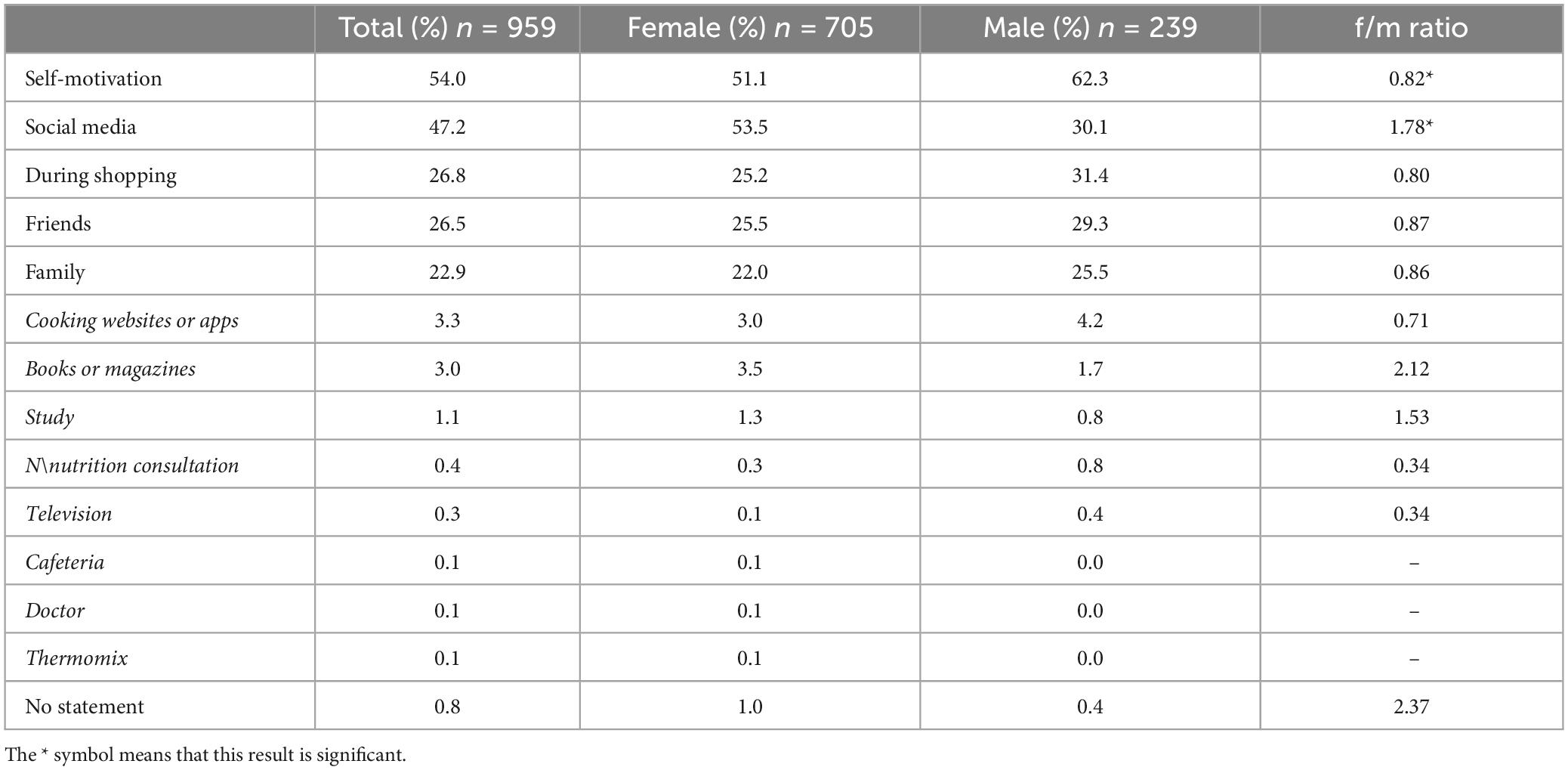
Table 4. Inspiration for nutrition (up to two answers per person) answers in italic have been given in the category “other.”
Forms of diet
A vegetarian diet was the predominant form of nutrition (33.7% at ZR1) (Table 5). Both vegetarian and vegan diets became more popular during the lockdown. At ZR2, the share of students following a vegetarian diet rose to 38.4%, and a significant increase in veganism was also found (Table 5).
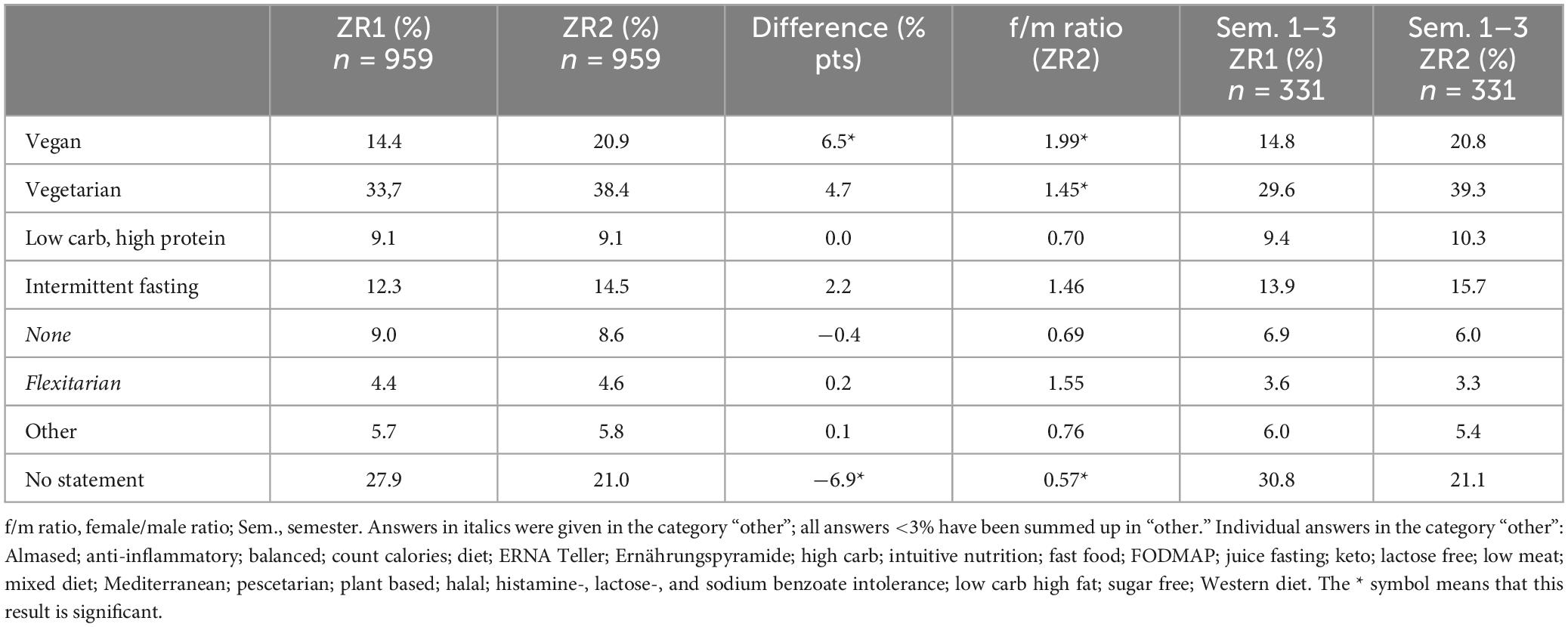
Table 5. Common diet forms at ZR1 and ZR2, by gender and new students (up to two answers per person).
The diet forms “low carb,” “high protein,” and “other” were dominant among male students. Significantly more female students followed a vegan or vegetarian diet at both ZR1 and ZR2 (Table 5 and Figure 3). Both men and women reported increases in vegetarianism and veganism. However, at ZR2, female students reported a greater increase in the vegan diet than male students did in the vegetarian diet.
The number of vegetarian and vegan students differed among the four forms of housing (Figure 4). At ZR2, 32.7% of vegetarians and 31.2% of vegans were living in shared flats. The smallest proportions were students living with their parents (20.1 and 15%, respectively). Special diets, noted in “other,” were mainly followed by students living with their partner (37.6%).
Food preparation methods and eating out of home
At ZR1, respondents were preparing fresh meals, on average, 3.96 days per week and using ready-to-prepare products 1.72 days per week. Ready-to-eat products (0.88 d/wk) and meals out of home were consumed even less frequently (Table 6). Significantly more respondents stated that they prepared fresh meals every day at ZR2 (22.8% at ZR2 vs. 18.7% at ZR1) and tried new recipes more frequently (1.49 d/wk at ZR2 vs. 1.07 d/wk at ZR1). This trend was especially evident among female students. In total, respondents reported consuming ready-to-prepare products less often (1.54 d/wk at ZR2 vs. 1.72 d/wk at ZR1) and ready-to-eat products more often (0.92 d/wk at ZR2 vs. 0.88 d/wk at ZR1). Takeaway services in restaurants (0.34 d/wk at ZR2 vs. 0.28 d/wk at ZR1) and delivery services (0.49 d/wk at ZR2 vs. 0.34 d/wk at ZR1) were also chosen more often. Female students reported preparing fresh meals more often than male students (4.23 d/wk among females vs. 3.37 d/wk among males) at ZR2. By contrast, men ate ready-to-eat products more often (1.14 vs. 0.76 d/wk) and more frequently bought food in diners or fast-food restaurants (0.81 d/wk at vs. 0.55 d/wk) (Figure 5).
The greatest changes from ZR1 to ZR2 were observed for “try new recipes,” where the number of participants trying new recipes less than once per week decreased significantly (17.9%), while numbers in all other groups increased. The same pattern, albeit less pronounced, was observed for ready-to-eat products. Fewer participants used ready-to-prepare products or fast food/diner meals. Increases were greatest for cooking fresh, food delivery, and cooking boxes.
Bars with negative values indicate a decrease in the number of participants choosing the related category. The wider the range, the greater the changes.
Fruits and vegetables
At ZR1, vegetables were consumed on 5.41 days per week, slightly more frequently than fruits (4.73 d/wk). The daily intake of vegetables and fruits was confirmed by 48% and 40.3% of participants, respectively. These proportions increased at ZR2 to 50.6% for vegetables and 43.3% for fruits (Table 7). Moreover, 57.7% of all respondents ate vegetables or fruits every day. A significant increase was found for the consumption of legumes, with the mean consumption frequency increasing by 7.8%, from 2.25 d/wk at ZR1 to 2.42 d/wk at ZR2 (Table 7).
Meat, dairy products, and plant-based alternatives
A significant decrease in the frequency of consumption of milk and dairy products was observed when comparing ZR2 and ZR1 (2.99 d/wk at ZR2 vs. 3.4 d/wk at ZR1); at the same time, the frequency of consumption of plant-based milk alternatives increased from 2.18 d/wk at ZR1 to 2.76 d/wk at ZR2 (Table 7). Less meat and fewer sausages were also eaten (1.58 d/wk at ZR2 vs. 2.03 d/wk at ZR1) in favor of a significantly increased consumption of plant-based meat alternatives (1.22 d/wk at ZR2 vs. 0.85 d/wk at ZR1).
Drinks
Significant increases in the frequency of consumption from ZR1 to ZR2 were found for coffee (2.81 d/wk at ZR1 to 3.02 d/wk at ZR2) and tea (3.38 d/wk at ZR1 to 3.62 d/wk at ZR2) (Table 7). The proportion of students who drank alcoholic beverages between 1 and 4 days per week at ZR1 decreased at ZR2. At the same time, there was an increase in the number of students consuming alcohol every day (4.1% at ZR2 vs. 1.9% at ZR1) and never (29.8% at ZR2 vs. 25.5% at ZR1) (Table 7 and Figure 6).
Bars with negative values indicate a decrease in the number of participants choosing the related category of consumption frequency. The wider the range, the greater the changes.
Sustainability-related aspects
At ZR1, the most relevant sustainability criteria were animal welfare (30.2 + 38.3%) and climate and environment protection (20.2 + 40.8%) (Figure 7). The fewest number of respondents stated that they found labor conditions important (8.9 + 27.6%). During the pandemic, organic products (59.8% at ZR2 vs. 45.1% at ZR1), climate and environment protection (73.3% at ZR2 vs. 61% at ZR1), seasonality (57.9% at ZR2 vs. 43.7% at ZR1), and storability (54% at ZR2 vs. 41.7% at ZR1) became significantly more important. However, all aspects were rated more positively than at ZR1, except for the low price for food, where the consent decreased marginally from 49.3 to 48.8%. Female students rated all aspects at ZR1 and ZR2 as more important than male students did.
University catering
Students reported having visited university canteens at ZR1 1.55 days per week; cafeterias were visited half as often (0.65 d/wk) and vending machines almost never (0.11 d/wk) (Table 8). The frequency of usage in all instances decreased dramatically at ZR2 (Table 8). During the pandemic, students especially missed contact with others in the canteens (46.8 + 27.5%) and the function of canteens as meeting points (38.8 + 32.1%) (Table 9).
Discussion
The obtained sociodemographic data are congruent with the findings of previous studies, which enables a comparison and discussion of the data (8, 19, 41, 42). The four typical forms of housing for students were all reported at a similar rate. These results differ from previous data that identified shared flats as the dominant form of housing for students (11, 12). This observation is likely explained by the pandemic-associated lockdown, with students in shared flats moving back to their parents or to their partner (5, 7).
Male respondents stated significantly more often that they were not eating a healthy and balanced diet, as they also did in other studies. This phenomenon could be related to social expectations regarding beauty ideals, which affect mainly women (43, 44). Another explanation could be the previously mentioned characteristic that especially young females respond positively to health-associated DPs, including vegetarian and vegan diets (2, 35). The more frequent meat consumption of male students (2.6 d/wk at ZR2 vs. 1.2 d/wk at ZR1) matches this assumption. However, the percentage of vegetarian male students increased faster during ZR2 than the percentage of female students did.
Almost all students who started to follow a vegan diet at ZR2 had already been vegetarian for a certain amount of time before the lockdown. Most other students who began to follow a special diet at ZR2 did not follow any diet before and moved toward vegetarianism. These results confirm the findings of other studies (13, 15, 41). Especially students in the first three semesters, who had recently gained knowledge about healthy diets and nutrition in their lectures and had new social contacts, started to follow a vegetarian or vegan diet (Table 5). Hence, changes in their DPs could be attributed to influences from the study and other students (4). The more than 10% total increase in “non-meat-eating students” during the lockdown was higher than was found in the cross section of the population but was lower than the increase of 21% found in a study at the HAW Hamburg (45).
Social media has become highly relevant for young people, which is reflected in the importance of social media in gathering inspiration for their own nutrition and DPs. Especially during the COVID-19 pandemic, it was easier for students to use the internet than to meet friends or family members (7). Inspirational sources such as books, magazines, and television shows, which are more important for older people, were not important for the younger population (46). The most common argument is that “self-motivation” is a subjective term that cannot be addressed and discussed objectively. However, it is a statement of felt independence, self-control, or freedom to act (47), representing the positive thinking of students during the lockdown.
The 39.5% increase in the number of students who tried new recipes at ZR2 is comparable to the 55% increase in another sample in the study by Bühlmeier et al. (8). Generally, the frequency of fresh food preparation due to the SARS-CoV-2 pandemic has also been congruently described in other studies (19, 24, 48–50). The “Fachkraft 2030” study found that 83% of the surveyed students cooked fresh foods several times per week already before the pandemic, but 18% reported eating ready-to-eat products regularly, 43% regularly ate out of home, and only 3% frequently used delivery services (42, 51). The increasing trend of fresh cooking was already present before the pandemic but increased during the lockdown, especially for young people (8, 14), meaning that students react more or faster to extraneous influences than the general population (15, 19). However, only 22.8% of the students stated that they prepared fresh meals every day, which was less than half the proportion in the German population (14).
Countries and people with a low household income seem to skip meals more often and consume less fresh food than those with a high HNI (52). Moreover, increasing food insecurity has been reported (22, 53). This behavior could not be observed for students in our study, even though many of them had a low HNI. Fresh preparation of meals was chosen more often at ZR2 than at ZR1, and ready-to-prepare products were consumed less frequently (Table 6). The increased use of delivery services is contrary to the results of some other countries (54–56) but congruent with other findings Chen et al. (50) and the German population (41).
The increase in consumption of fruits and vegetables has been described before (8, 15, 53, 56–59). In Germany, the proportion of people eating vegetables or fruits every day increased insignificantly during the pandemic, from 70 to 72% (13, 14). Compared to Bühlmeier et al. (8) or Busch et al. (19) findings, where more than 20% of the respondents reported eating more fruits and vegetables, the students in the present sample ate only 2.6% more vegetables and 3% more fruits.
What is remarkable is the significantly increased consumption of legumes during the pandemic, which is also consistent with the results of the study by Maharat et al. (56). At ZR2, the proportion of students who stated they would never eat legumes increased. This increase can be explained by the fact that legumes are often used in university catering or restaurants (22, 60, 61). As the canteens closed, many students stopped consuming legumes. Legumes are an indicator of sustainability-oriented DPs, especially for vegetarians and vegans (62). The significant 7.8% increase in the frequency of consumption of legumes during the lockdown could suggest that the increased consumption of legumes may have occurred primarily among those who already consumed legumes in ZR1.
Influences of the pandemic on the sustainability-related aspects of students’ DPs could be linked to the consumption frequency of animal products and their plant-based alternatives. The decreasing frequency of consumption of meat, milk, and dairy products at ZR2, together with the significant increase in the consumption of alternatives, is evidence of changing DPs. A reduced consumption of dairy and meat products has also been shown in other studies with young adults and students, respectively (56, 63). It especially represents the sustainability-oriented behavior of the German society (38). At least 47% of the German population bought plant-based alternatives at least once (14). The students in this study, however, also consumed less cheese at ZR2, which is contrary to the general German population (62, 64). The reduced intake of milk or yogurt was compensated for by an increased consumption of cheese, but students in the present study did not seem to follow this trend. Even though there were almost no adequate plant-based cheese alternatives available at the beginning of the pandemic. Students substituting animal products with alternatives was special and likely originated from the high interest in sustainability-related topics (36, 62).
Even though the frequency of alcohol consumption did not change from ZR1 to ZR2, a characteristic change in the consumption pattern was observed: During the lockdown, students did not attend parties but started to drink more at home. Our results do not match those of previous studies (26, 48). The study results on alcohol consumption by students during the pandemic vary internationally. A measured increase in alcohol consumption was found in a survey on mental wellbeing during the pandemic (65). Another study states that alcohol consumption among students has fallen as they have moved back into their parents’ home during the lockdown and this may be a reason for a reduction in alcohol consumption (66). However, some surveys documented fewer purchases of alcohol during the pandemic, which can result in less frequent consumption (58).
Several studies have described and discussed an increased consumption of sweets during the pandemic (8, 57, 67–69). However, our data do not confirm these findings. Instead, a negligible decrease of 0.01 days per week was observed (Table 9). In a different study with students, a slight decrease was also observed (70). Since sweets and ready-to-eat products bear the distinct societal stigma of being “unhealthy,” undesirable foods, self-reporting of the consumption rates of these products is potentially delicate in terms of underreporting (62). Regarding these foods, men react differently than women, who are often suppressed by societal pressure to be slim (43). Hence, women react more sensitively to questions about sweets and might have overreported their consumption of sweets, while men tend to overreport ready-to-eat products, as they are a status symbol (44). Male students stated that they ate significantly more ready-to-eat products than did women (25.3 vs. 12.8%) and used food delivery services more frequently (4.9 vs. 2.1%).
Increased sensitivity to effects of private food consumption has been the subject of several studies (8, 19, 25, 49). Especially the importance of regionality and animal welfare matches the general trend described for Germany (13, 14). The significant increase in the consumption of organic products is notable, although it is associated with increased expenses (71). This result is therefore a strong signal for changed attitudes.
In addition to the established criteria, aspects such as packaging and storability have been surveyed since their importance increased not only for students, but also for other groups (14, 19, 41). Storability has become an indicator of the fear of food shortages (24). Regarding social and ethical motives in the present study, sensitivity toward animal welfare also outweighed the aspect of fair labor conditions in the food production and processing sector. In previous surveys, labor conditions also had the smallest consent of all sustainability-related criteria (72). However, it seems unlikely that students do not find labor conditions unimportant. This observation may be explained by a lack of information (19, 72).
Price consciousness, which had already decreased for several years before the pandemic (13, 14), was confirmed by our results. In contrast to findings by Busch et al. (19), in the present study, students seemed to prioritize the quality of food and to appreciate sustainability-related aspects even more at ZR2 than at ZR1. In this respect, the lockdown seemed to have sharpened their awareness of sustainability and health-oriented DPs.
The closure of university catering had a direct impact on students’ social interactions. They compensated for the lack of meals in canteens and cafeterias by preparing meals themselves and using takeaway and delivery services. Evidence of the shift toward sustainability-oriented diets was found in the increase in the number of vegetarian and vegan students, the consumption frequency of legumes, and the substitution of animal products with plant-based alternatives. Hence, the closure of university catering and the lockdown due to the COVID-19 pandemic had a substantial impact on the DPs of university students.
In conclusion, it can be stated that the results could give answers to the three underlying questions. The survey results show that the DPs of university students in Germany changed significantly during the SARS-CoV-2 pandemic. The increase in the consumption of legumes and plant-based alternatives indicate changes in DPs, led by sustainability-oriented criteria. Differences in these students compared with the general population became evident regarding the consumption of legumes, plant-based alternatives, snacks, sweets, and alcoholic beverages. The high interest in sustainable food and animal welfare confirms the results of previous studies and underline the relevance of these aspects for students. Despite dramatic changes in their daily routines, students seemed to adapt to more positive DPs than unfavorable ones, especially regarding the consumption of sweets and alcohol. Thus, their own motivation to eat more sustainably and healthily seems to have outweighed the negative emotions caused by a lack of social contact, a lower income, and the loss of everyday campus life. This makes it clear to how the DPs have changed and what the main motivations for this have been. The closed university catering also had an impact here. At the same time, the social component of these places came into effect as well.
Data availability statement
The raw data supporting the conclusions of this article will be made available by the authors, without undue reservation.
Ethics statement
Ethical approval was not required for the studies involving humans because participation in the study was anonymous. The studies were conducted in accordance with the local legislation and institutional requirements. The participants provided their informed consent to participate in this study by clicking the “continue” button in the start page.
Author contributions
JD: Conceptualization, Investigation, Methodology, Project administration, Writing – review and editing, Writing – original draft. AB: Writing – original draft, Formal Analysis, Visualization. SL: Conceptualization, Methodology, Supervision, Writing – original draft. CS: Supervision, Writing – review and editing. MS: Writing – original draft, Conceptualization, Methodology, Supervision, Writing – review and editing.
Funding
The author(s) declare that no financial support was received for the research, authorship, and/or publication of this article.
Conflict of interest
The authors declare that the research was conducted in the absence of any commercial or financial relationships that could be construed as a potential conflict of interest.
Publisher’s note
All claims expressed in this article are solely those of the authors and do not necessarily represent those of their affiliated organizations, or those of the publisher, the editors and the reviewers. Any product that may be evaluated in this article, or claim that may be made by its manufacturer, is not guaranteed or endorsed by the publisher.
References
1. Besa K, Kochskämper D, Lips A, Schröer W, Thomas S. Stu.diCo II – Die corona pandemie aus der perspektive von studierenden. Hildesheim: Universitätsverlag Hildesheim (2021). doi: 10.18442/194
2. Rückert-John J. Den Ernährungsalltag verstehen: Ein Beitrag der ernährungssoziologie für eine interdisziplinäre ernährungsforschung. Berlin: Ernährungs-Umschau (2017).
3. Knoblauch H. Kulturkörper. In: M Schroer editor. Soziologie des körpers, originalausg. Frankfurt: Auflage Suhrkamp (2005). p. 92–113.
4. Abdelhafez A, Akhter F, Alsultan A, Jalal S, Ali A. Dietary practices and barriers to adherence to healthy eating among King Faisal university students. Int J Environ Res Public Health. (2020) 17:8945. doi: 10.3390/ijerph17238945
5. Bolumole M. Student life in the age of COVID-19. High Educ Res Dev. (2020) 39:1357–61. doi: 10.1080/07294360.2020.1825345
6. Loades M, Chatburn E, Higson-Sweeney N, Reynolds S, Shafran R, Brigden A, et al. Rapid systematic review: The impact of social isolation and loneliness on the mental health of children and adolescents in the context of COVID-19. J Am Acad Child Adolesc Psychiatry. (2020) 59:1218-1239.e3. doi: 10.1016/j.jaac.2020.05.00.
7. Conrad R, Hahm H, Koire A, Pinder-Amaker S, Liu C. College student mental health risks during the COVID-19 pandemic: Implications of campus relocation. J Psychiatr Res. (2021) 136:117–26. doi: 10.1016/j.jpsychires.2021.01.054
8. Bühlmeier J, Frölich S, Ludwig C, Knoll-Pientka N, Schmidt B, Föcker M, et al. Changes in patterns of eating habits and food intake during the first German COVID-19 lockdown: Results of a cross-sectional online survey. Eur J Nutr. (2022) 67:3293–306. doi: 10.1007/s00394-022-02919-7
9. Quack D. Auswirkungen der covid-19-pandemie auf die globale ernährungssituation. STErn Projekt Öko-Institut e. V. Freiburg im Breisgau (2021).
10. Beine M, Noël R, Ragot L. Determinants of the international mobility of students. Econ Educ Rev. (2014) 41:40–54. doi: 10.1016/j.econedurev.2014.03.003
11. Middendorff E, Apolinarski B, Becker K, Bornkessel P, Brandt T, Heißenberg S, et al. Die wirtschaftliche und soziale lage der studierenden in Deutschland 2016. Berlin: Bundesministerium für Bildung und Forschung (BMBF) (2017).
12. Nixon E, Trickey A, Christensen H, Finn A, Thomas A, Relton C, et al. Contacts and behaviours of university students during the COVID-19 pandemic at the start of the 2020/2021 academic year. Sci Rep. (2021) 11:11728. doi: 10.1038/s41598-021-91156-9
13. Bundesministerium für Ernährung und Landwirtschaft [BMEL].Deutschland, wie es isst: Der BMEL-ernährungsreport 2020. Berlin: Bundesministerium für Ernährung und Landwirtschaft (2020).
14. Bundesministerium für Ernährung und Landwirtschaft [BMEL].Deutschland, wie es isst: Der BMEL-Ernährungsreport 2022. Berlin: Bundesministerium für Ernährung und Landwirtschaft (2022).
15. Jordan I, Keding G, Stosius L, Hawrysz I, Janiszewska K, Heil E. Changes in vegetable consumption in times of COVID-19–first findings from an international civil science project. Front Nutr. (2021) 8:686786. doi: 10.3389/fnut.2021.686786
17. Profeta A, Smetana S, Enneking U, Heinz V, Kircher C. Der einfluss der corona-pandemie auf den lebensmittelkonsum der verbraucher. Berichte über landwirtschaft - zeitschrift für agrarpolitik und landwirtschaft. Beiträge: Aktuelle Beiträge (2021). doi: 10.12767/BUEL.V99I1.334
18. Busch G, Bayer E, Gunarathne A. Einkaufs– und ernährungsverhalten sowie resilienz des ernährungssystems aus sicht der bevölkerung: Eine studie während der corona-pandemie im november 2020 ergebnisse der dritten befragungswelle. Göttingen: Universität Göttingen Diskussionsbeitrag (2020).
19. Busch G, Bayer E, Iweala S, Mehlhose C, Rubach C, Schütz A, et al. Einkaufs– und ernährungsverhalten sowie resilienz des ernährungssystems aus sicht der bevölkerung: Eine studie während der corona-pandemie im november 2020 ergebnisse der dritten befragungswelle. Göttingen: Universität Göttingen Diskussionsbeitrag (2021).
20. Aiyar A, Pingali P. Pandemics and food systems – towards a proactive food safety approach to disease prevention & management. Food Secur. (2020) 12:749–56. doi: 10.1007/s12571-020-01074-3
21. Rivera-Ferre M, López-i-Gelats F, Ravera F, Oteros-Rozas F, di Masso E, Binimelis M, et al. The two-way relationship between food systems and the COVID19 pandemic: Causes and consequences. Agric Syst. (2021) 191:103134. doi: 10.1016/j.agsy.2021.103134
22. Fanzo J, Rudie C, Sigman I, Grinspoon S, Benton T, Brown M, et al. Sustainable food systems and nutrition in the 21st century: A report from the 22nd annual Harvard nutrition obesity symposium. Am J Clin Nutr. (2022) 115:18–33. doi: 10.1093/ajcn/nqab315
23. Cavallo C, Sacchi G, Carfora V. Resilience effects in food consumption behaviour at the time of COVID-19: perspectives from Italy. Heliyon. (2020) 6:e05676. doi: 10.1016/j.heliyon.2020.e05676
24. Deschasaux-Tanguy M, Druesne-Pecollo N, Esseddik Y, de Edelenyi FS, Allés B, Andreeva VA, et al. Diet and physical activity during the coronavirus disease 2019 (COVID-19) lockdown (March-May 2020): results from the French NutriNet-Santé cohort study. Am J Clin Nutr. (2021) 113:924–38. doi: 10.1093/ajcn/nqaa336
25. Filimonau V, Archer D, Bellamy L, Smith N, Wintrip R. The carbon footprint of a UK University during the COVID-19 lockdown. Sci Total Environ. (2021) 756:143964. doi: 10.1016/j.scitotenv.2020.143964
26. Janssen M, Chang BP, Hristov H, Pravst I, Profeta A, Millard J. Changes in food consumption during the COVID-19 pandemic: Analysis of consumer survey data from the first lockdown period in Denmark, Germany, and Slovenia. Front Nutr. (2021) 8:635859. doi: 10.3389/fnut.2021.635859
27. Casas R, Raidó-Quintana B, Ruiz-León AM, Castro-Barquero S, Bertomeu I, Gonzalez-Juste J, et al. Changes in Spanish lifestyle and dietary habits during the COVID-19 lockdown. Eur J Nutr. (2022) 61:2417–34. doi: 10.1007/s00394-022-02814-1
28. Urhan M, Aysin E. Nutritional and health behaviour predictors of the weight gain during the COVID-19 pandemic. Eur J Nutr. (2022) 61:2993–3002. doi: 10.1007/s00394-022-02862-7
29. Isenrich C, Würth K, Linke-Pawlicki S, Winkler G. Ernährungsbezogenes verbraucherverhalten in der corona-pandemie. Berlin: Hauswirtschaft und Wissenschaft (2021).
30. Neely E, Walton M, Stephens C. Young people’s food practices and social relationships. A thematic synthesis. Appetite. (2014) 82:50–60. doi: 10.1016/j.appet.2014.07.005
31. Ferrera C. The college experience: Physical activity, nutrition, and implications for intervention and future research. J Exerc Physiol Online. (2009) 12:23–35.
32. Martinez-Lacoba R, Pardo-Garcia I, Amo-Saus E, Escribano-Sotos F. Socioeconomic, demographic and lifestyle-related factors associated with unhealthy diet: A cross-sectional study of university students. BMC Public Health. (2018) 18:1241. doi: 10.1186/s12889-018-6149-3
33. Zurita-Ortega F, San Román-Mata S, Chacón-Cuberos R, Castro-Sánchez M, Muros J. Adherence to the mediterranean diet is associated with physical activity, self-concept and sociodemographic factors in university student. Nutrients. (2018) 10:966. doi: 10.3390/nu10080966
34. Palmer K, Bschaden A, Stroebele-Benschop N. Changes in lifestyle, diet, and body weight during the first COVID 19 ‘lockdown’ in a student sample. Appetite. (2021) 167:105638. doi: 10.1016/j.appet.2021.105638
35. Robert Koch Institute [RKI].Verbreitung der vegetarischen ernährungsweise in Deutschland. RKI-Bib1. Berlin: Robert Koch Institute (2016).
36. Brombach C. Soziale dimensionen des ernährungsverhaltens. Ernahrungs Umschau. (2011) 2011:318–25. doi: 10.4455/eu.2011.970
37. Hemmi N, Brombach C. Junge forschung: Kochen und essen während des Lockdowns. Ernährungs Umschau. (2020) 8:M448.
38. Zühlsdorf A, Jürkenbeck K, Schulze M, Spiller A. Politcized eater: Jugendreport zur zukunft nachhaltiger ernährung. Göttingen: University of Göttingen (2021).
39. Bruno R, Canet L, Lemarchand B, Neitthoffer B. Social influences on consumption choices in university catering: A multi-agent modelling approach using GAMA. Proceedings of the 1st conference GAMA days 2021. Toulouse: (2021).
40. Eysenbach G. Improving the quality of web surveys: The checklist for reporting results of internet E-surveys (CHERRIES). J Med Internet Res. (2004) 6:e34. doi: 10.2196/jmir.6.3.e34
41. Rückert-John J, Ruppenthal T, Schweers N, Werking J. Ernährungsalltag im wandel. veränderungen, wertorientierungen und zukunftserwartungen. Fulda: Umfrageergebnisse (2022).
42. Studitemps GmbH, Maastricht University.Fachkraft 2030: 9. und 10. Erhebung zur wirtschaftlichen und allgemeinen lebenssituation der studierenden in Deutschland. Maastricht: Maastricht University (2019).
43. Setzwein M. Männliches lustprinzip und weibliches Frustprinzip. Ernährungs Umschau. (2004) 51:504–7.
45. Rausche P. Erhebungsmethodik des student surveillance systems der HAW Hamburg: Eine vergleichende mixed-method analyse der paper-pen- und der online erhebungsmethodik im susy projekt. Hamburg: Hochschule für Angewandte Wissenschaften Hamburg (2021).
46. Mörixbauer A, Gruber M, Derndorfer E. Handbuch ernährungskommunikation, lehrbuch. Berlin: Springer Spektrum (2019).
47. Werner K, Milyavskaya M. Motivation and self-regulation: The role of want-to motivation in the processes underlying self-regulation and self-control. Soc Pers Psychol Compass. (2018) 13:e12425. doi: 10.1111/spc3.12425
48. Huber SG, Helm C. Lernen in Zeiten der Corona-Pandemie. Die Rolle familiärer Merkmale für das Lernen von Schüler*innen. Befunde vom Schul-Barometer in Deutschland, Österreich und der Schweiz. In: Fickermann D, Edelstein B editors. Langsam Vermisse ich die Schule.” Schule Während und Nach der Corona-Pandemie. Münster: Waxmann (2020). p. 37–60. doi: 10.25656/01:20228
49. Sandi Wachyuni S, Wiweka K. THE CHANGES IN FOOD CONSUMPTION BEHAVIOR: A RAPID OBSERVATIONAL STUDY OF COVID-19 PANDEMIC. Int J Manag Innov Entrep Res. (2020) 6:77–87. doi: 10.18510/ijmier.2020.628
50. Chen H, Marzo R, Anton H, Abdalqader M, Rajasekharan V, Baobaid M, et al. Dietary habits, shopping behavior and weight gain during covid-19 pandemic lockdown among students in a private university in Selangor, Malaysia. J Public Health Res. (2021) 10:2921. doi: 10.4081/jphr.2021.2921
51. Knappe A, Seegers P. Sonderauswertung zur Studienreihe “Fachkraft 2020”. Maastricht: Studium und Ernährung (2017).
52. Hawkes C, Squires C. A double-duty food systems stimulus package to build back better nutrition from COVID-19. Nat Food. (2021) 2:212–4. doi: 10.1038/s43016-021-00260-6
53. Coulthard H, Sharps M, Cunliffe L, van den Tol A. Eating in the lockdown during the COVID 19 pandemic; self-reported changes in eating behaviour, and associations with BMI, eating style, coping and health anxiety. Appetite. (2021) 161:105082. doi: 10.1016/j.appet.2020.105082
54. Di Renzo L, Gualtieri P, Pivari F, Soldati L, Attinà A, Cinelli G, et al. Eating habits and lifestyle changes during COVID-19 lockdown: an Italian survey. J Transl Med. (2020) 18:229. doi: 10.1186/s12967-020-02399-5
55. Luo M, Wang Q, Yang S, Jia P. Changes in patterns of take-away food ordering among youths before and after COVID-19 lockdown in China: The COVID-19 impact on lifestyle change survey (COINLICS). Eur J Nutr. (2022) 61:1121–31. doi: 10.1007/s00394-021-02622-z
56. Maharat M, Sajjadi SF, Moosavian SP. Changes in dietary habits and weight status during the COVID-19 pandemic and its association with socioeconomic status among Iranians adults. Front Public Health. (2023) 10:1080589. doi: 10.3389/fpubh.2022.1080589
57. Allabadi H, Dabis J, Aghabekian V, Khader A, Khammash U. Impact of COVID-19 lockdown on dietary and lifestyle behaviours among adolescents in Palestine. Dyn Hum Health. (2020) 7:2170.
59. Chenarides L, Grebitus C, Lusk J, Printezis I. Food consumption behavior during the COVID-19 pandemic. Agribusiness. (2021) 37:44–81. doi: 10.1002/agr.21679
60. Willett W, Rockström J, Loken B, Springmann M, Lang T, Vermeulen S, et al. Food in the anthropocene: The EAT–lancet commission on healthy diets from sustainable food systems. Lancet. (2019) 393:447–92. doi: 10.1016/S0140-6736(18)31788-4
61. Gazan R, Maillot M, Reboul E, Darmon N. Pulses twice a week in replacement of meat modestly increases diet sustainability. Nutrients. (2021) 13:3059. doi: 10.3390/nu13093059
62. Deutsche Gesellschaft für Ernährung [DGE].DGE-ernährungsbericht. Bonn: Deutsche Gesellschaft für Ernährung (2020).
63. Bertrand L, Shaw K, Ko J, Deprez D, Chilibeck P, Zello G. The impact of the coronavirus disease 2019 (COVID-19) pandemic on university students’ dietary intake, physical activity, and sedentary behaviour. Appl Physiol Nutr Metab. (2021) 46:265–72. doi: 10.1139/apnm-2020-0990
65. Charles N, Strong S, Burns L, Bullerjahn M, Serafine K. Increased mood disorder symptoms, perceived stress, and alcohol use among college students during the COVID-19 pandemic. Psychiatry Res. (2021) 296:113706. doi: 10.1016/j.psychres.2021.113706
66. White H, Stevens A, Hayes K, Jackson K. Changes in alcohol consumption among college students due to COVID-19: Effects of campus closure and residential change. J Stud Alcohol Drugs. (2020) 2020:725–30.
67. Hänisch N. Veränderung des konsumentenverhaltens und des images der landwirtschaft durch die corona-pandemie. Neubrandenburg: Bachelorarbeit, Hochschule Neubrandenburg (2020).
68. Romeo-Arroyo E, Mora M, Vázquez-Araújo L. Consumer behavior in confinement times: Food choice and cooking attitudes in Spain. Int J Gastron Food Sci. (2020) 21:100226. doi: 10.1016/j.ijgfs.2020.100226
69. Buckland N, Swinnerton L, Ng K, Price M, Wilkinson L, Myers A, et al. Susceptibility to increased high energy dense sweet and savoury food intake in response to the COVID-19 lockdown: The role of craving control and acceptance coping strategies. Appetite. (2021) 158:105017. doi: 10.1016/j.appet.2020.105017
70. Szczepańska E, Janota B, Mąkosza K, Zięba N, Wlazło M, Czapla M. Consumption of selected groups of food products by medical and non-medical students during the Covid-19 pandemic. Rocz Panstw Zakl Hig. (2022) 73:173–81.
71. Bund Ökologische Lebensmittelwirtschaft [BÖLW].Branchenreport 2021: Ökologische lebensmittelwirtschaft. Berlin: Bund Ökologische Lebensmittelwirtschaft (2021).
Keywords: students, SARS-CoV-2, dietary practices, sustainability, university catering, public health nutrition
Citation: Dreyer JO, Brandt AC, Lichtenstein S, Sina C and Smollich M (2024) Impacts of the SARS-CoV-2 pandemic on the dietary practices of university students in Germany. Front. Nutr. 11:1302308. doi: 10.3389/fnut.2024.1302308
Received: 26 September 2023; Accepted: 19 February 2024;
Published: 08 March 2024.
Edited by:
Betty Pei Ing Chang, European Food Information Council, BelgiumReviewed by:
Hurtado José Antonio, University of Alicante, SpainMuhammad Fawad Rasool, Bahauddin Zakariya University, Pakistan
Seyedeh Parisa Moosavian, Shiraz University of Medical Sciences, Iran
Copyright © 2024 Dreyer, Brandt, Lichtenstein, Sina and Smollich. This is an open-access article distributed under the terms of the Creative Commons Attribution License (CC BY). The use, distribution or reproduction in other forums is permitted, provided the original author(s) and the copyright owner(s) are credited and that the original publication in this journal is cited, in accordance with accepted academic practice. No use, distribution or reproduction is permitted which does not comply with these terms.
*Correspondence: Jana O. Dreyer, ZHJleWVyLmphbmFAZ214Lm5ldA==
†ORCID: Jana O. Dreyer, orcid.org/0000-0001-6047-0125; Alexander C. Brandt, orcid.org/0000-0001-6299-1960; Martin Smollich, orcid.org/0000-0003-1297-8535
 Jana O. Dreyer
Jana O. Dreyer Alexander C. Brandt1†
Alexander C. Brandt1† Christian Sina
Christian Sina Martin Smollich
Martin Smollich